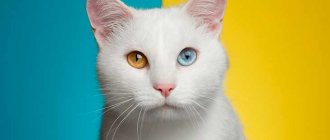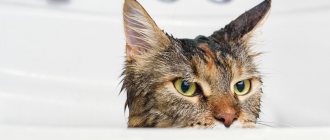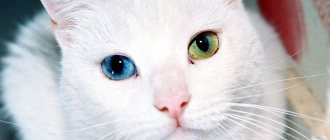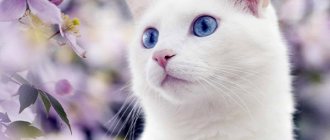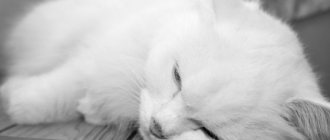The white color represents everything bright, good, and pleasant, so superstitious people believe that a cat of this color in the house brings good luck, happiness and goodness. At all times, light-colored cats were considered a sign of aristocracy, prosperity, and positive change. Noble citizens loved to keep them, believing that they were a sign of luxury and elitism.
White cat in the house
A white cat straying towards a house is considered a symbol of good news and changes in life for the better. Many beliefs say that having such a cat in the house will help protect household members from the evil eye, dangerous magical influences and from all evil spirits.
In some countries, a white pet is adopted as a mascot. It is believed that this will bring them luck, prosperity and success in any endeavor.
For those who want to get married as soon as possible, it is recommended that 7 snow-white kittens be placed in good hands.
It is a good sign for a woman to have a snow-white cat in her home, especially if the pet has different eye colors. In this case, she radiates happiness, attracts men, reveals her best qualities, becomes kind, gentle and caring. In addition, white cats are able to recognize and treat diseases.
White cat on the street
If a cat of this color comes across the path of the newlyweds, they will have a strong and long life together, prosperous and filled with love and happiness. Meeting a white cat on the street is a good omen, especially if it crossed the road. In this case, it is recommended to make a cherished wish; it will definitely come true. People rushing on business or to a meeting may hope to conclude a profitable deal.
If a cat is often seen on the street or comes to the very doorstep, not wanting to leave, you should not drive away your own happiness. You definitely need to let him into your home and give him love and care.
Signs about white cats
Snow-colored pets usually turn out to be a noble breed and quite expensive. But such a kitten is worth having in your home, even if it costs a pretty penny. According to superstitions, they carry a positive charge to future owners:
- collect negative energy and destroy it, bringing peace and tranquility to the house;
- relieve stress, which is very important for people working in a tense and nervous environment;
- bring good luck (especially pets with heterochromia);
- will provide the home with harmony, love and good luck in everything;
- guarantees success in all endeavors.
A white cat crossing the road promises good luck, a new acquaintance, or the fulfillment of your deepest desire. Optimistic people believe that it is a symbol of new beginnings that will bring profit.
Other signs
- If visually impaired people touch the cat's tail more often, they can count on improved vision.
- Don't offend the animal. She may simply stop helping you.
- Cats see Brownie and in almost all cases become friends with him. If your cat is acting out at night, but you don’t understand why he is so active, remember about the invisible friend Brownie. It is better not to disperse such a cheerful company;
- A cat must enter a new home. If she is also white, she will bring longevity of marriage and happiness to the family.
- A sneezing white cat promises a good marriage for a young girl.
Don't neglect signs. Invisible helpers, our Angels give us signals and signs in every possible way. They can also act through cats, who, better than anyone, sense the subtle world still unknown to us.
Mr. Cat recommends: the opinion of scientists
Scientists have conducted studies to find out whether snow-white cats can help the owner in the fight against various kinds of pathologies. Surprisingly, this theory has received scientific confirmation.
They were able to find out that a variety of cats with a light coat color is capable of using its own energy field to influence the following indicators of the body’s functioning:
- balance a person’s mental state;
- normalize the functioning of internal organs;
- increase brain activity;
- eliminate depression and stress;
- improve rates of disease that requires surgical intervention.
If you have health and emotional problems, it is better to seek the help of doctors and psychoanalysts. However, it is allowed to use cute snow-white pets as an additional source of energy. Unlike black and white, red or tricolor ones, they are able to sensitively respond to changes in the functioning of the vital systems of the host’s body and have a beneficial effect, restoring them.
Are cats with different eyes a miracle of nature that carries a mysterious mystical meaning or an ordinary external flaw that should be avoided?
Many of us have encountered this anomaly, but hardly anyone was interested in the cause of this mysterious phenomenon.
This deviation from the norm has a scientific basis and is called “heterochromia,” which means a difference in the color of the iris, as well as the pigmentation characteristics of individual areas of the skin and fur. Scientists have discovered that heterochromia occurs as a result of an imbalance in the body of melanin (the pigment that is responsible for color), i.e. its shortage or excess.
There are complete and partial heterochromia, as well as congenital and acquired. Complete heterochromia is considered when the color of one eye is completely different from the other. Sometimes this option occurs when the color of both eyes is very light, i.e. In both cases, pigmentation is impaired. Partial heterochromia, also called sector, manifests itself differently. One part of the iris is noticeably different in color from another part of the same eye.
Among animals, the most striking well-known example is the white cat with different eyes; heterochromia is much more common than in humans. It is most common among cats and dogs, as well as horses, cows and Asian buffalos. To a greater extent, they have complete heterochromia, i.e. when one eye is highly pigmented (most often brown, less often orange, yellow or green), and the second has a lack of pigment and therefore its iris has a white, gray or blue color.
But among animals there are those that are more susceptible to heterochromia, namely representatives of white, marbled and light colors. For example, cats that are white or tri-colored, husky or marbled dogs, such as marbled dachshunds, Australian shepherds and others, as well as piebald horses.
Thus, different eye colors in animals can be found in representatives that belong to completely different breeds and are in no way related to each other. At the same time, they are outstanding representatives of their breeds and are no worse than others, which means heterochromia can be considered a completely acceptable deviation from the norm, which is often endowed with mystical meaning.
But, despite this, odd-eyed cats whose breed is called the Turkish Van, as well as the Turkish Angora, all without exception have this feature, which is inherited by them from generation to generation and is considered a characteristic feature. People simply call them “different-eyed”. As a rule, representatives of these breeds have white fur, and the eye color is distributed in such a way that one eye is blue, and the other is soft copper, yellow or bright orange.
In dogs, complete heterochromia is most common in representatives of the Siberian Husky breed, and partial heterochromia is most common in dogs of such breeds as the Australian Shepherd and Border Collie. But different eye colors are inherited in breeds - American Foxhound Terrier, Collie, Dalmatian, German Shorthaired Pointer or German Shorthaired Pointer, Dunker or Norwegian Hound, Great Dane, Dachshund, Scottish Shepherd and Whippet.
Returning to the Turkish Van cats, which are more often called Van cats, it must be said that they are considered symbolic animals and enjoy extraordinary respect in their homeland. According to ancient legend, the favorite cat of the world famous prophet Muhammad was the odd-eyed beauty Muizza. At the same time, according to popular belief, these cats not only protect the house, but also help their owners achieve their goals. A striking example of this is the fact that the political career of later American President Bill Clinton rapidly took off after the appearance of a Van odd-eyed cat in his house.
If you like an odd-eyed cat, you can buy it not only in Turkey. Just choose the breed you like and ask nurseries if they have such a baby, and you will definitely find your future pet.
As we have already indicated earlier, most people associate an odd-eyed cat with mystical phenomena, because even knowing the natural cause of this feature, looking into these magical eyes, it’s as if you fall into a trance and begin to think about miracles. In addition, famous Turkish fortune tellers also attribute extraordinary abilities to such cats. For example, at the entrance to one of the salons where such a fortune teller receives, there is a sign with a picture of a Van cat, and the seer conducts the session together with her charming pet, who, apparently, helps her.
Thus, photos of odd-eyed cats, which can often be found on the Internet, are more likely to arouse genuine interest and delight rather than disdain. It is quite natural that everyone’s attitude towards this feature may be different. Some perceive it as a defect, some kind of flaw or a bad sign, while others, on the contrary, believe that a pet with different eye colors is a gift of fate, which is certainly a source of pride, a kind of exoticism and clear evidence that the owner of such A unique animal can only become an equally exceptional person. Therefore, the latter treat their pets with special care and reverence, carefully protecting their dear “friend”. As they say, it's all a matter of taste and you shouldn't judge either side.
Moreover, cats are always a sea of joy and an ocean of happiness in the house, regardless of the color of their eyes. They are happy to help you forget the failures and difficulties you encountered throughout the day, and get rid of the pain that periodically bothers you and prevents you from enjoying life. Often, these animals also have incredible energy and are keenly aware of not only people, but also upcoming events, protecting their owner from troubles. Therefore, you should not follow generally accepted standards, and when choosing a pet, be guided by your heart!
The difference in the shade of the iris of the eyes is called heterochromia. This anomaly is quite rare in humans. More often you can see odd-eyed cats or dogs. In most cases, heterochromia is not a consequence of a disease or pathology, but is associated with a malfunction in the pigment production mechanism. Sometimes it is inherited; this trait is typical for several breeds of cats.
Features of heterochromia
Cat fans have different views on this phenomenon. Some people deliberately look for such a pet and consider it a symbol of good luck and prosperity. They are rightfully proud of their unique cat, groom and cherish it, providing ideal conditions so that the pet remains a reliable talisman for as long as possible.
There are reasons for this attitude towards animals with different eyes. Many nations have a belief that the presence of such a cat in the house guarantees protection and helps the owner achieve any goal. Followers of Islam know that the Prophet Muhammad loved his odd-eyed pet Muizza very much. There is also modern evidence in favor of cats with heterochromia. As soon as Bill Clinton had such an animal in his house, he soon managed to win the election and become president.
There are also people among cat lovers who consider odd-eyed pets to be representatives of evil spirits. During the Inquisition, women with heterochromia were called witches and burned at the stake. Many eastern fortune tellers and sorcerers get a cat with different eyes in order to enlist the help of otherworldly forces.
And yet there is no reason to consider a pet with different eyes a bad sign. It is better to get acquainted with the scientific explanations of heterochromia and treat this phenomenon adequately.
Types of heterochromia
Experts distinguish several types of these anomalies. The criterion by which they are classified is the distribution of shades on the iris. Heterochromia can be:
- full,
- annular,
- sectoral.
In its full form, the anomaly appears as a uniformly colored iris. For the most part, one eye has a rich blue color, the other can be yellow, orange, green, copper, etc.
With ring heterochromia, both irises have the same shade. But on one of them there is a ring-shaped area, painted in a different color. A sectoral anomaly characterizes the presence of an area with a color that does not coincide with the general shade. This phenomenon can occur in one eye or both.
In most cases, a kitten is born with impaired pigmentation of the iris. Sometimes the anomaly is acquired; a change in the color of one eye is caused by certain external reasons. There are cat breeds in which heterochromia is a genetic trait.
Reasons for the anomaly
A congenital anomaly is not a disease; the body of an odd-eyed cat functions in the same way as that of ordinary pets. There are no changes in visual acuity. The only disorder that in some cases may occur in animals with different eye colors is poor hearing or complete deafness. Therefore, breeders of purebred cats discard such kittens and do not use them for breeding.
Heterochromia can occur in animals of any color. But most often, an abundance or deficiency of pigments occurs in pets with white, light fur, and tricolor cats. Typically, pronounced differences in eye color appear by three months of age.
Acquired heterochromia is a consequence of the use of certain medications or indicates the presence of a disease. For example, in the treatment of glaucoma, eye drops are used, the components of which activate the production of melanin. As a result, the iris takes on a darker shade. Lightening is often a sign of diseases:
- leukemia,
- melanoma,
- uevita,
- diabetes,
- neuroblastoma, etc.
Acquired heterochromia should be the reason for a visit to the veterinarian and diagnostic testing.
How does it affect your pet's health?
Quite often, cats pay for different colors of the iris with hearing impairment, even complete hearing loss. With an equal degree of probability, an animal may be deaf in one ear or both.
One-sided deafness or significant hearing loss in one ear and complete loss in the other are also possible. The phenomenon occurs if the cause of different-colored eyes is a genetic factor, which often disrupts the development of the hearing aid. But this is not a rule, and the animal may turn out to be full-fledged.
Deafness is not found in all cats with unusual appearance.
Because of this, before selling kittens, a conscientious breeder usually obtains a veterinary report on the condition of the animal. A kitten with partial or complete deafness costs less than a fully hearing one.
Different eye colors as a sign of breed
Different eye colors are not always an anomaly. There are cat breeds in which this trait is inherited and is considered one of the characteristic traits. These include:
- turkish angora,
- kao mani,
- Turkish van.
Representatives of these breeds have a snow-white color or white is the main color in them.
Various disasters and wars have put the Turkish Angora breed under threat of complete extinction. The disaster was prevented by the attention of the Turkish government to these animals. Now cats of this breed are under state protection and are a national treasure.
The most expensive and rare pet is the Kao Mani cat. Since time immemorial, these animals have lived in Thailand. Short-haired snow-white cats, like representatives of the Turkish Angora, are protected by the state and are considered the national breed of Thailand.
The Turkish Van breed is the result of selection. The ancestors of modern representatives were wild cats living on the shores of Lake Van. The main prey of these predators is fish. Each hair of the thick, semi-long coat is well lubricated with subcutaneous fat. The cat does not get wet during water hunting.
It was the Turkish Vans that made odd-eyed pets popular. In the Turkish city of Van, a monument was erected to an odd-eyed cat. One eye represents the sun, has a golden tint, the second symbolizes the sky, its color is blue.
Heterochromia in animals of these breeds manifests itself similarly. One eye has a deep blue tint. The color of another iris can be amber, honey, green, orange.
How to cancel a bad omen
If a white fluffy lump crossed your path at night, and you consider yourself to be a suspicious person and do not want to take risks:
- Grasp the button.
- Hold on to something iron.
- Cross your fingers.
- Break the first twig you come across in two and throw the halves in different directions away from you. The signs say: you have broken the “cat’s path” and can go wherever you want without fear.
- Turn 360 degrees in place. It is believed that after this you have started a new path that the cat has not yet had time to cross.
- Finally, wait for someone less superstitious to cross the cat's path.
Everything is relative. For example, in England, not so far from us, white cats are not liked, but black cats are welcomed as if they were their own! Which once again proves: it doesn’t matter what the signs mean, what matters is how we ourselves relate to them.
Heterochromia in other breeds
As an anomaly, different eye colors can appear in animals of different breeds. This phenomenon is often observed in cats:
- marble and tortoiseshell color,
- Persian,
- exotics,
- sphinxes,
- oriental,
- British, British
- Scottish,
- rex.
You can see odd-eyed cats among the yard tricolors. In most cases, different shades of the iris are formed in animals whose color white occupies more than half of the body area.
The manifestation of this feature is unpredictable and can occur in cats of any breed. There is only one condition for the formation of different colors of the iris. The animal must have a white gene that is inherited.
How do eyes get their color?
Eye pigment is produced by pigment-producing cells called melanocytes, which are present in the iris. The exact color and its intensity will depend on the number and activity of melanocytes in the iris. If there are no melanocytes, the eye will be blue. A low content of melanocytes results in a green color, and a high content of melanocytes creates an orange (sand, brown) color. If melanocytes are less active, the intensity of a given color will be lighter and vice versa. The activity of melanocytes is determined genetically. Several genes at different locations on the chromosomes control the pigmentation of the iris.
Heterochromia in white cats
In albino cats, the formation of heterochromia occurs according to a special pattern. These animals have a dangerous dominant gene W. There are several types of it. If kittens receive the gene in a homozygous form, they die in the mother's womb.
The presence of the W element in domestic white cats can negatively affect the formation and development of the nervous system. This gene can cause serious dysfunction of the organs of vision and hearing, leading to blindness and deafness.
If heterochromia is not a sign of the breed, and deviations in the animal’s behavior are observed, then it is worth taking your pet to a veterinarian and undergoing an examination. It is also necessary to visit a veterinary hospital in case of acquired anomaly, in order to exclude the presence of secondary diseases that could contribute to the appearance of eye color in the animal.
A cat is a unique animal with exceptional qualities: acute sense of smell, night vision, and acute hearing. For a long time, unimaginable legends about cats have been born. Many of them featured animals with different colored eyes (heterochromia). This feature has been known since the Middle Ages. Today scientists can give a complete answer to what it is and what it is connected with.
Strange eyes and deafness
Deafness in white cats appears to be associated with the white spot gene and the dominant white gene. It is more common in cats with blue eyes or heterochromia. As experts explain, this is due to the fact that the white gene can sometimes cause degradation of the cochlea without disrupting the migration of melanocytes into one or both eyes. The cochlea is the part of the inner ear involved in hearing. This results in permanent deafness in one or both ears.
Multi-colored eyes can be found in completely different breeds. Heterochromia is a normal deviation because such cats are no different from the rest. If your cat with multi-colored eyes is deaf, with proper maintenance and care she will give you the same love and devotion as ordinary cats.
What is heterochromia
Heterochromia is a phenomenon in which there is a difference in the color of the iris of the right and left eyes. This phenomenon exists in two variations:
- complete heterochromia - eyes of different colors;
- partial - segments of the iris of one of the eyes differ.
With partial heterochromia, one eye is colored two different colors
The phenomenon of heterochromia in representatives of the cat family is not uncommon. Such animals fully retain their visual functions. The most common manifestation of the deviation is complete heterochromia. One of the eyes may be green, yellow or orange, while the other is only blue.
Melanin, or rather, its lack, is responsible for the heavenly color of the cornea. Odd-eyed cats are predominantly white in color. Similar manifestations also occur in colorful animals, but they are rare.
Heterochromia in cats is a common occurrence, but in cats of different colors (not white in color) it is much less common.
Causes of heterochromia in cats
Today, the causes of heterochromia in a particular individual are not fully understood. There is ongoing debate about whether this is a mutation or a gift of nature. However, different eye colors do not in any way interfere with a cat’s vision and the development of the animal as a whole.
Heterochromia is a congenital phenomenon. However, the color of one of the eyes may change due to:
- the injury received;
- previous illness of inflammatory etiology;
- problems with ophthalmology;
- presence of cancer;
- long-term treatment with medications.
I had the most ordinary kitten, gray-striped in appearance. The color of the eyes, like all babies, was a dull gray-blue. When he learned to crawl, he began to actively explore the surroundings of his box. And then one night I woke up from a plaintive “meowing”. It turned out that the kitten had moved into the dog’s territory, and the dog decided to play with it. The dog only licked the small furry creature, but to the kitten it looked like a real monster. Of course, he was selected, washed of drool and delivered to his mother cat. And a week later, I noticed that the baby’s eye color had become different: greenish-yellow in one and sky blue in the other. We still don’t understand what this is connected with, but we think that the cause could well be trauma from too much love from our dog. The kitten has grown up, hears and sees perfectly, but his different eyes always attract the attention of all our guests. It looks really unusual.
Deafness of odd-eyed cats
According to statistics, white cats with blue eyes suffer from hearing problems. Deafness can be complete or partial. This is due to degeneration of the inner ear. But pure white cats with green and yellow eyes have normal hearing.
A white cat with blue eyes most often has hearing problems
If a cat has heterochromia and one of the eyes is blue, then her ear will not hear on that side. This feature of albinos has been studied since the beginning of the 19th century. Many researchers subsequently found a direct relationship between white coat color, blue eyes and lack of hearing.
Deafness in cats with white fur and blue eyes occurs due to abnormalities in the genetic code. The “white” gene dominates, influencing the process of formation of the animal even in the embryonic state. This has been proven experimentally.
A 1997 study examined cats with varying degrees of hearing loss. 72% of the cats examined were deaf. It was discovered that the organ of Corti degenerated completely within the first few weeks after birth. But even during these first weeks, auditory stimuli did not elicit a response in the brainstem, suggesting that these animals had never experienced sound sensations. It was also found that several months after the degeneration of the organ of Corti, the nerve cells of the cochlea of the inner ear began to degenerate.
The primary formation of the analysis of sound signals begins in the Organ of Corti
https://www.sciencedirect.com/science/article/pii/S0378595597001822?via%3Dihub
A white kitten with blue eyes will not necessarily be deaf. It is necessary to trace the pedigree: if among his ancestors there were Siamese cats or Thais, then the blue color of the eyes is due to heredity, and not pathology.
Video: heterochromia in cats
Acquired heterochromia iridis
Acquired different eyes cannot be passed on to kittens from affected parent cats. Certain conditions can cause a cat's eye to change color, which usually occurs later. Terms include:
Uveitis
Uveitis is an inflammation of the uveal tract of the eye, consisting of the iris, choroid and ciliary body. It is a painful condition that, if left untreated, can lead to blindness. Uveitis can be an isolated problem or a symptom of other diseases. This includes:
- Eye injury
- Bacterial or fungal infection
- Diabetes
- Tumors
- Feline herpes
- High blood pressure
Some cats with uveitis will scratch at the affected eye, while others will try to avoid contact with the affected eye altogether. Other cats may keep their eyes closed and may become aggressive if a person tries to approach them.
Most cats with uveitis avoid bright light because it causes pain or discomfort. Squinting, redness and blurred vision are clear signs that something is wrong.
Glaucoma
Feline glaucoma is when the aqueous humor (aqueous humor) in the front of the eye behind the lens fails to drain properly. The fluid then builds up, putting pressure on the optic nerve. Typical signs include cloudy, milky eyes.
The Journal of the US National Library of Medicine warns that although glaucoma in cats is relatively rare, it is likely that many cases in cats go unrecognized. It usually starts in one eye and then spreads to the other, leading to blindness.
Portosystemic hepatic shunt
Copper-colored eyes may be a sign of a liver portosystemic shunt, an abnormal vessel that allows blood from the animal's intestines to bypass the liver. As a result, toxins, proteins, hormones and nutrients absorbed by the intestines enter the liver. Instead, they will circulate throughout the body, causing liver function to deteriorate.
Not all cats with portosystemic liver shunt will develop copper-colored eyes, but it may be an immediate symptom.
Article Author: Richard Parker I'm Richard, I have experience in all matters related to feline health, behavior, grooming techniques and general pet care. Richard graduated with a degree in journalism in 2008. He is the proud owner of 5 adult cats (all adopted stray breeds), including an older cat who is now 20 years old.
Cat breeds with different eyes
There are several snow-white breeds that often give birth to kittens with different eyes.
Turkish van
The breed got its name from the Van district in Turkey. Cats of this family are active and cheerful. They love contact with people, quickly get used to the family and then do not get off their hands.
In addition to the pure white color, the Turkish Van can be tortoiseshell. There is wool interspersed with red, black and gray, as well as brown shades. As a rule, the eyes are different, most often yellow and blue.
Turkish Vans often have individuals with heterochromia
Cats have very soft fur that is pleasant to the touch. Turkish Vans have good jumping abilities. “Taking” the mezzanine from its place is a piece of cake. These cats, like no other, love to bathe and swim, and are easy to train. Commands such as “sit” and “lie down” are mastered no worse than dogs. It is very easy to teach them to fetch a ball or give a paw.
Turkish Angora
The Turkish Angora is another breed with white fur and multi-colored eyes. Although there are representatives with a marbled coat, black and cream. The breed got its name in honor of the city of Angora, located in Byzantium, from where it was brought to Europe. The weight of an adult cat is only 3–4 kg. She has an elegant physique, developed muscles and a stable immune system.
The Turkish Angora is distinguished by fluffy, soft fur and an almost complete absence of undercoat. Like other representatives of odd-eyed cats, the ear on the side of the blue eye is predisposed to deafness. A hearing defect can be compensated by devotion to only one person, peacefulness and tolerant attitude towards other pets in the house. Turkish Angora cats are very picky eaters. The diet of such an animal must be selected carefully.
The Turkish Angora is characterized by a white color, which is often combined with heterochromia
Khao mani
Thailand became the birthplace of khao mani. The name of the breed can be translated as “white pearl”. Such cats were kept only in the courts of kings. Hundreds of years later, these beauties began to appear in the homes of ordinary people. However, not everyone can afford to buy a Khao Mani kitten. Their prices are very high. Representatives of this breed have short fur, a small body size and a slightly elongated muzzle. Keeping them is a real pleasure. Kao mani are unpretentious in food and clean. These animals love attention and cannot stand loneliness.
Kao mani is another representative of animals from the world of odd-eyed animals
Other breeds with heterochromia
A white kitten with different-colored eyes can be found among representatives of other breeds, but this will be an exception rather than a pattern. So, such representatives are found among:
- British Shorthair;
- any subspecies of Scottish cat;
- Persian cats;
- orientals;
- Devon and Cornish Rex;
Cornish Rex dogs have different eyes rather than the exception rather than the rule.
Mystical signs about cats with different colored eyes
From a psychic point of view, such an animal becomes a talisman for the home, bringing good luck. Esotericists say that cats with eyes of different colors carry only pure energy, becoming guardians and healers of the family in which they live. And besides, such a cat will become an excellent friend to the brownie.
Regardless of eye color and breed, the pet will be the keeper of the family hearth and comfort
Folk signs associated with odd-eyed cats say:
- if the pet does not give way, then fate will soon favor its owner;
- if an animal disappears from home for several days, then it leads to impending disaster;
- If on the street a cat with different eyes runs across the road, then plans should be postponed.
Even during the Inquisition, when cats were considered accomplices of Satan, cats with different eyes were mistaken for angelic messengers.
No matter what people and signs say, if a kitten with different eyes appears in the house, then this is good luck. There will be harmony in the family, and peace in the soul. The most important thing is that a loyal pet will become your best friend.
The difference in the shade of the iris of the eyes is called heterochromia. This anomaly is quite rare in humans. More often you can see odd-eyed cats or dogs. In most cases, heterochromia is not a consequence of a disease or pathology, but is associated with a malfunction in the pigment production mechanism. Sometimes it is inherited; this trait is typical for several breeds of cats.
How to avoid the consequences predicted in signs
Most omens associated with a pet are good and favorable. In rare cases of negative interpretation, it is recommended not to dwell on the information received. Particularly sensitive people may hold onto a button on their clothing or a metal object, such as a set of keys.
It is often advised to make a circle around your axis, cross your fingers, or break the first twig you come across on the road. In this case, it is advisable to read the conspiracy or whisper. It is permissible to use any of the well-known texts directed against the effects of unfavorable signs.
White cats are credited with the ability to attract happiness, protect against the evil eye and damage, and repel evil spirits. Most will accept positive ones. The impact of negative superstitions can be reduced with the help of simple rituals and spells.
Features of heterochromia
Cat fans have different views on this phenomenon. Some people deliberately look for such a pet and consider it a symbol of good luck and prosperity. They are rightfully proud of their unique cat, groom and cherish it, providing ideal conditions so that the pet remains a reliable talisman for as long as possible.
There are reasons for this attitude towards animals with different eyes. Many nations have a belief that the presence of such a cat in the house guarantees protection and helps the owner achieve any goal. Followers of Islam know that the Prophet Muhammad loved his odd-eyed pet Muizza very much. There is also modern evidence in favor of cats with heterochromia. As soon as Bill Clinton had such an animal in his house, he soon managed to win the election and become president.
There are also people among cat lovers who consider odd-eyed pets to be representatives of evil spirits. During the Inquisition, women with heterochromia were called witches and burned at the stake. Many eastern fortune tellers and sorcerers get a cat with different eyes in order to enlist the help of otherworldly forces.
And yet there is no reason to consider a pet with different eyes a bad sign. It is better to get acquainted with the scientific explanations of heterochromia and treat this phenomenon adequately.
Types of heterochromia
Experts distinguish several types of these anomalies. The criterion by which they are classified is the distribution of shades on the iris. Heterochromia can be:
- full,
- annular,
- sectoral.
In its full form, the anomaly appears as a uniformly colored iris. For the most part, one eye has a rich blue color, the other can be yellow, orange, green, copper, etc.
With ring heterochromia, both irises have the same shade. But on one of them there is a ring-shaped area, painted in a different color. A sectoral anomaly characterizes the presence of an area with a color that does not coincide with the general shade. This phenomenon can occur in one eye or both.
In most cases, a kitten is born with impaired pigmentation of the iris. Sometimes the anomaly is acquired; a change in the color of one eye is caused by certain external reasons. There are cat breeds in which heterochromia is a genetic trait.
Types of odd eyes
According to the method of occurrence, heterochromacy in cats can be congenital or acquired.
According to the distribution of the iris of the eye, they are distinguished:
- full;
- sectoral;
- ring
Complete heterochromacy is when one iris of a cat is blue, and the other is any other color.
Sector discordance is determined by the fact that only some part of one or both irises is painted a different color.
Ring implies the presence on the iris of the eye of a kind of ring of a different color from the main color, usually along the edge.
Reasons for the anomaly
A congenital anomaly is not a disease; the body of an odd-eyed cat functions in the same way as that of ordinary pets. There are no changes in visual acuity. The only disorder that in some cases may occur in animals with different eye colors is poor hearing or complete deafness. Therefore, breeders of purebred cats discard such kittens and do not use them for breeding.
Heterochromia can occur in animals of any color. But most often, an abundance or deficiency of pigments occurs in pets with white, light fur, and tricolor cats. Typically, pronounced differences in eye color appear by three months of age.
Acquired heterochromia is a consequence of the use of certain medications or indicates the presence of a disease. For example, in the treatment of glaucoma, eye drops are used, the components of which activate the production of melanin. As a result, the iris takes on a darker shade. Lightening is often a sign of diseases:
- leukemia,
- melanoma,
- uevita,
- diabetes,
- neuroblastoma, etc.
Acquired heterochromia should be the reason for a visit to the veterinarian and diagnostic testing.
Is this a disease?
Congenital heterochromacy is not a disease and does not affect a cat’s visual acuity in any way. But it can affect your hearing.
But if we are talking about purebred animals, then such an individual is removed from the breeding program in order to minimize the possibility of the birth of deaf kittens and stop the spread of the defect in this species.
We invite you to familiarize yourself with the Cat family - species and representatives of predatory animals
There are two types of acquired heterochromacy:
- Abnormal darkening of the iris. It is caused by iron deposition (siderosis) and can also be triggered by the use of certain eye drops by stimulating melanin growth. These are, for example, drugs to reduce intraocular pressure, which are used to combat glaucoma.
- Abnormal lightening occurs due to atrophy of the iris due to inflammation, due to neuroblastoma, melanoma, uevitis, leukemia and some other pathologies.
Different eye colors as a sign of breed
Different eye colors are not always an anomaly. There are cat breeds in which this trait is inherited and is considered one of the characteristic traits. These include:
- turkish angora,
- kao mani,
- Turkish van.
Representatives of these breeds have a snow-white color or white is the main color in them.
Various disasters and wars have put the Turkish Angora breed under threat of complete extinction. The disaster was prevented by the attention of the Turkish government to these animals. Now cats of this breed are under state protection and are a national treasure.
The most expensive and rare pet is the Kao Mani cat. Since time immemorial, these animals have lived in Thailand. Short-haired snow-white cats, like representatives of the Turkish Angora, are protected by the state and are considered the national breed of Thailand.
The Turkish Van breed is the result of selection. The ancestors of modern representatives were wild cats living on the shores of Lake Van. The main prey of these predators is fish. Each hair of the thick, semi-long coat is well lubricated with subcutaneous fat. The cat does not get wet during water hunting.
It was the Turkish Vans that made odd-eyed pets popular. In the Turkish city of Van, a monument was erected to an odd-eyed cat. One eye represents the sun, has a golden tint, the second symbolizes the sky, its color is blue.
Heterochromia in animals of these breeds manifests itself similarly. One eye has a deep blue tint. The color of another iris can be amber, honey, green, orange.
How are congenital multi-colored eyes obtained?
During development, stem cells migrate to another part of the body where they differentiate into specialized cell types. Some of them migrate through the embryo and stop in the eye, where they later become melanocytes. Under certain conditions, melanocytes cannot enter one of the eyes. This results in one eye having melanocytes, which give it pigmentation (green, amber or brown), while the other eye remains blue due to a lack of melanocytes.
This situation usually occurs in solid white cats or cats with white spots. The dominant white gene (the gene that makes cats completely white) and the white spot gene sometimes interfere with the migration of melanocytes into one of the eyes. This condition is rare in cats that lack these two genes. In non-white cats, different colored eyes are often the result of differently developed eyes in the embryo. These congenital strange eyes are hereditary and can be passed on to a cat's kittens. This applies to such cat breeds as:
- Turkish van;
- Turkish Angora;
- kao-mani;
- British Shorthair;
- subspecies of Scottish cat.
Heterochromia in other breeds
As an anomaly, different eye colors can appear in animals of different breeds. This phenomenon is often observed in cats:
- marble and tortoiseshell color,
- Persian,
- exotics,
- sphinxes,
- oriental,
- British, British
- Scottish,
- rex.
You can see odd-eyed cats among the yard tricolors. In most cases, different shades of the iris are formed in animals whose color white occupies more than half of the body area.
The manifestation of this feature is unpredictable and can occur in cats of any breed. There is only one condition for the formation of different colors of the iris. The animal must have a white gene that is inherited.
cat eyes
A cat's eyes are significantly larger compared to the size of its head. This is actually a key feature of all nocturnal animals, as is the vertical structure of the pupils. The actual eyeballs are placed in bony cavities called orbits. The white part of the eye is called the sclera, and it is covered by a thin membrane called the conjunctiva. The conjunctiva closes the eyelids. Before the eyes is a transparent dome cornea. The cornea protects the eyes and allows light to pass through. The round colored area of the eye is the iris.
Cats are quite poor at discerning small details, but the theory that cats see the world in black and white is considered incorrect. Interestingly, cats have a third eyelid, which can be seen when the cat is happy or sick.
Heterochromia in white cats
In albino cats, the formation of heterochromia occurs according to a special pattern. These animals have a dangerous dominant gene W. There are several types of it. If kittens receive the gene in a homozygous form, they die in the mother's womb.
The presence of the W element in domestic white cats can negatively affect the formation and development of the nervous system. This gene can cause serious dysfunction of the organs of vision and hearing, leading to blindness and deafness.
If heterochromia is not a sign of the breed, and deviations in the animal’s behavior are observed, then it is worth taking your pet to a veterinarian and undergoing an examination. It is also necessary to visit a veterinary hospital in case of acquired anomaly, in order to exclude the presence of secondary diseases that could contribute to the appearance of eye color in the animal.

